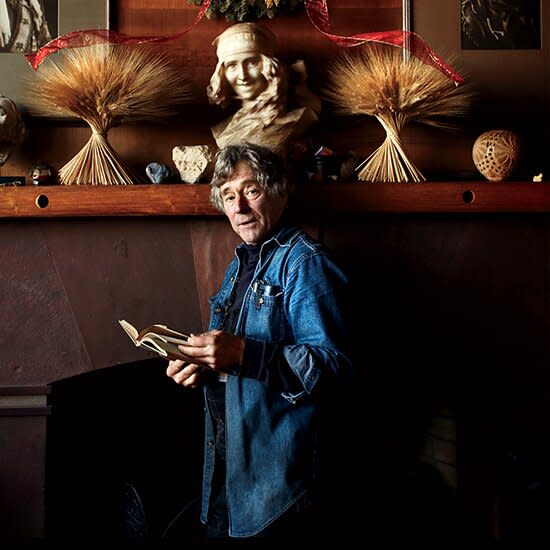Inside the Audacious Mind of an Unrepentant Wine Artisan

© Alex Farnum
Sean Thackrey is legendary for the quality (and elusiveness) of his largely Rhône-varietal wines, made from his tiny winery in the small, northern California town of Bolinas. He's also known for his articulate opinions on everything about wine; his comments express a kind of critical insight that was undoubtedly necessary in his first career as well. Thackrey was a prominent San Francisco art dealer before his switch to winemaking.
You were an art dealer before you were in the wine business, correct?
I was an art dealer for 25 years with a significant international reputation, and art is still one of the things I live on. My partner and I had a gallery in San Francisco called Thackrey & Robinson, which dealt with 19th- and early 20th-century prints and drawings, and particularly in early photography. That was my area of particular expertise, so we were really one of the pioneers in doing that.
But then you switched to wine—how did that happen?
When we managed to sell the Scottish Royal Academy's collection of calotypes by Hill and Adamson in 1977, I gave myself a nice bonus and bought my house in Bolinas. A couple of years later, I wanted to plant something along this rickety fence that goes along one side of it. And the first thing that came to mind was grapes. I had one of those old Sunset garden books, which talked about Thompson Seedless and Niagara grapes and so on, but I thought, come on. This is California! I should have some wine grapes up there. Then I thought, if I made some home wine just from the grapes along my fence,that would be kind of cool, right?
And then?
You know, it was like somebody sitting down at a piano and being like, hey, I might actually be able to play this thing. That was exactly my response. Since my own vines weren't going to be producing good grapes for several years, I went to a place in Berkeley with the very Berkeley name of "Wine and the People." What they did was actually very valuable: They provided absolutely first-rate wine grapes to home winemakers. The first stuff that I bought from them was some Cabernet Sauvignon from what was then the Fay Vineyard in Stag's Leap in Napa, and is now Stag's Leap Wine Cellars' property. It was a very quick slope up from there! The next year, in 1980, I went out and bought all of the necessary winemaking equipment, and my first release was from the vintage of 1981.
Just making a wine doesn't necessarily make people aware of it, or buy it, though.
Well, as I said, we were art dealers, and being art dealers you've got to have openings, and at openings, particularly in California, you've got to serve some wine. For my openings, I'd been buying wine from a place called Singer & Floyd; the principal partner was Stephen Singer, who was at that time married to Alice Waters, of Chez Panisse. So I went in there one day for a tasting and said, "Hey, Steven. I've just finished bottling my first wine, and I want to put it out there commercially. Would you like to taste it?" And he loved it, and brought it over to Chez Panisse, and they loved it…and, well, here I am. It just started on its own and basically has always been that way. I've never advertised a single time in my life.
It's always just been word of mouth?
Absolutely.
So, tell me something. The label on your red wine Pleiades says that its purpose is to "delight the jaded and irritate the wine police…" Who are the wine police?
Anyone who puts restrictions on what you're supposed to be able to enjoy. Like the idea that if a wine's 15 percent alcohol, it's undrinkable—it's hot, over-extracted, raw, a fruit bomb, doesn't show any subtlety, isn't French, and so on. Give me a break! Just taste it first, OK? People with those kind of absolute preconceptions, they're part of the wine police.
You've mentioned that you think of winemakers as being similar to chefs—how so?
One of my best friends is Daniel Patterson at Coi, in San Francisco. He's younger than I am, but we think almost identically. If you asked him, how do you cook fish, he'd say, show me the piece of fish and I can answer that question. That's exactly the way I feel about grapes.
I take it you feel there are plenty of winemakers who don't work that way?
If you ask a winemaker the right way to make Cabernet Sauvignon, and he says, well, you pick it at 24.3 brix and de-stem 100 percent, ferment on the skin for eight days, let the Cabernet reach a max temperature of 83.2 degrees, blah blah blah—that's just craziness, right? That approach is to winemaking is what in-flight meals are to food.
When you look out at the future of California wine, what do you see these days?
That's a good question—I don't know what I see! But I work in Bolinas, which is a very small coastal town in the middle of nowhere, basically, 27 miles north of San Francisco on Highway 1. And given the amount of work I do, I'm not really able to get up to Napa or Sonoma or wherever and socialize or keep in touch with what's being done. There's certainly a lot of b.s. and wines of absolutely no interest being made. But my supposition is that there's also a lot of great wine being made out there that's done in kind of the same scale that I operate on, and with some of the same ideas, that I just haven't happened to taste because I don't get around much.
